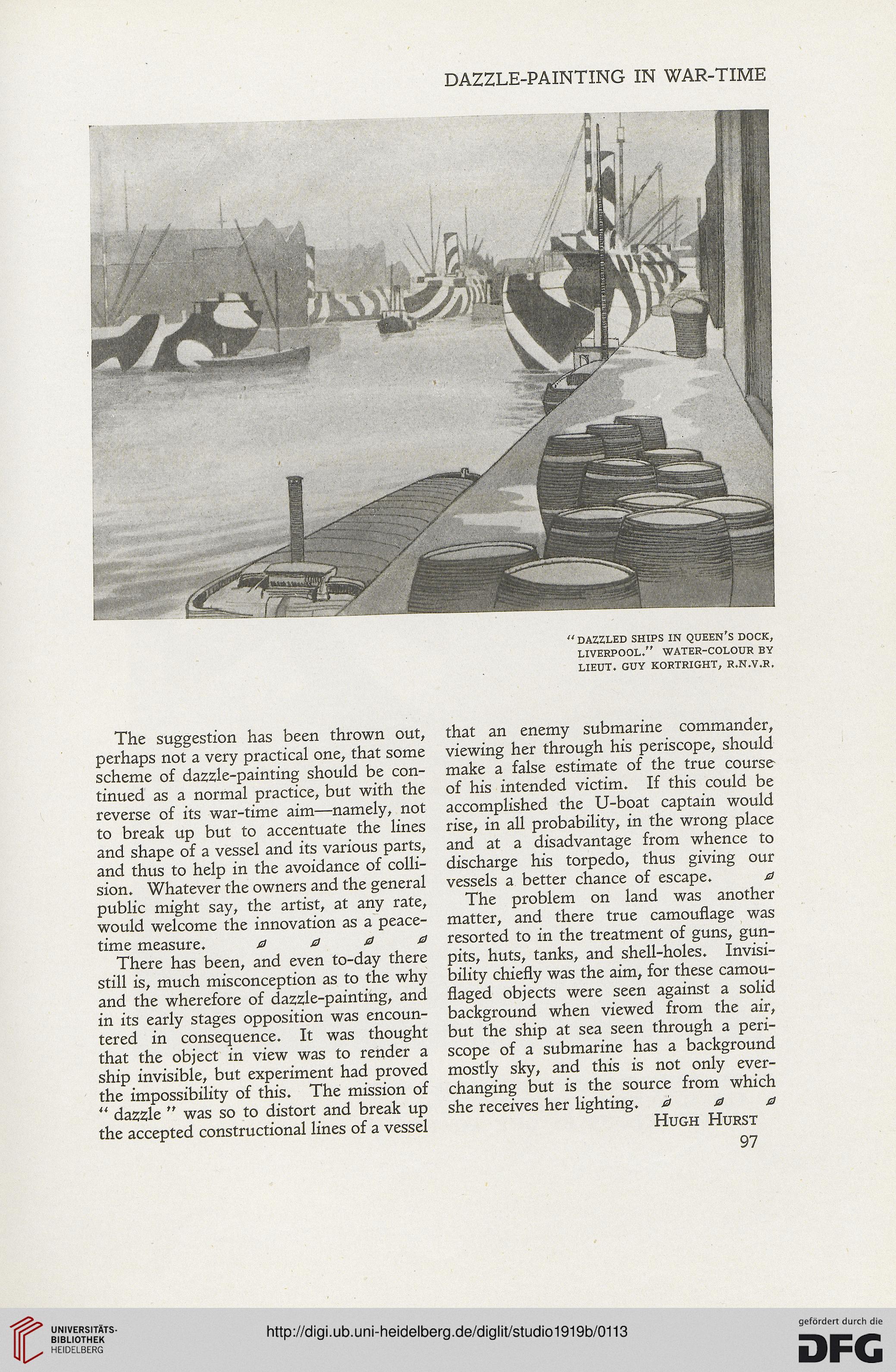DAZZLE-PAINTING IN WAR-TIME
“ DAZZLED SHIPS IN QUEEN’S DOCK,
LIVERPOOL.” WATER-COLOUR BY
LIEUT. GUY KORTRIGHT, R.N.V.R.
The suggestion has been thrown out,
perhaps not a very practical one, that some
scheme of dazzle-painting should be con-
tinued as a normal practice, but with the
reverse of its war-time aim—namely, not
to break up but to accentuate the lines
and shape of a vessel and its various parts,
and thus to help in the avoidance of colli-
sion. Whatever the owners and the general
public might say, the artist, at any rate,
would welcome the innovation as a peace-
time measure. a a a a
There has been, and even to-day there
still is, much misconception as to the why
and the wherefore of dazzle-painting, and
in its early stages opposition was encoun-
tered in consequence. It was thought
that the object in view was to render a
ship invisible, but experiment had proved
the impossibility of this. The mission of
“ dazzle ” was so to distort and break up
the accepted constructional lines of a vessel
that an enemy submarine commander,
viewing her through his periscope, should
make a false estimate of the true course
of his intended victim. If this could be
accomplished the U-boat captain would
rise, in all probability, in the wrong place
and at a disadvantage from whence to
discharge his torpedo, thus giving our
vessels a better chance of escape. a
The problem on land was another
matter, and there true camouflage was
resorted to in the treatment of guns, gun-
pits, huts, tanks, and shell-holes. Invisi-
bility chiefly was the aim, for these camou-
flaged objects were seen against a solid
background when viewed from the air,
but the ship at sea seen through a peri-
scope of a submarine has a background
mostly sky, and this is not only ever-
changing but is the source from which
she receives her lighting, a a a
Hugh Hurst
97
“ DAZZLED SHIPS IN QUEEN’S DOCK,
LIVERPOOL.” WATER-COLOUR BY
LIEUT. GUY KORTRIGHT, R.N.V.R.
The suggestion has been thrown out,
perhaps not a very practical one, that some
scheme of dazzle-painting should be con-
tinued as a normal practice, but with the
reverse of its war-time aim—namely, not
to break up but to accentuate the lines
and shape of a vessel and its various parts,
and thus to help in the avoidance of colli-
sion. Whatever the owners and the general
public might say, the artist, at any rate,
would welcome the innovation as a peace-
time measure. a a a a
There has been, and even to-day there
still is, much misconception as to the why
and the wherefore of dazzle-painting, and
in its early stages opposition was encoun-
tered in consequence. It was thought
that the object in view was to render a
ship invisible, but experiment had proved
the impossibility of this. The mission of
“ dazzle ” was so to distort and break up
the accepted constructional lines of a vessel
that an enemy submarine commander,
viewing her through his periscope, should
make a false estimate of the true course
of his intended victim. If this could be
accomplished the U-boat captain would
rise, in all probability, in the wrong place
and at a disadvantage from whence to
discharge his torpedo, thus giving our
vessels a better chance of escape. a
The problem on land was another
matter, and there true camouflage was
resorted to in the treatment of guns, gun-
pits, huts, tanks, and shell-holes. Invisi-
bility chiefly was the aim, for these camou-
flaged objects were seen against a solid
background when viewed from the air,
but the ship at sea seen through a peri-
scope of a submarine has a background
mostly sky, and this is not only ever-
changing but is the source from which
she receives her lighting, a a a
Hugh Hurst
97




